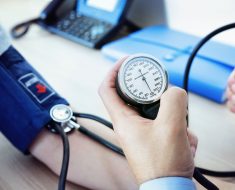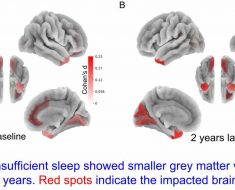Dr Zoe Williams discusses visceral fat on This Morning
When you subscribe we will use the information you provide to send you these newsletters. Sometimes they’ll include recommendations for other related newsletters or services we offer. Our Privacy Notice explains more about how we use your data, and your rights. You can unsubscribe at any time.
Non-alcoholic fatty liver disease (NAFLD) is characterised a build-up of fat in the liver. As the name suggests, the fatty build-up is not caused by alcohol intake. Rather, it is linked to chronic disease markers, such as obesity. The condition is highly pernicious because symptoms do not usually surface in the beginning.
In fact, as the PearTree Medical Centre explains, symptoms may not spring up until NAFLD has progressed to cirrhosis.
Cirrhosis is the most severe stage of NAFLD, occurring after years of inflammation, where the liver shrinks and becomes scarred and lumpy, the health body explains.
“This damage is permanent and can lead to liver failure (where your liver stops working properly) and liver cancer,” it warns.
Signs of cirrhosis include:
- Yellowing of the skin and the whites of the eyes (jaundice)
- Itchy skin
- Swelling in the legs, ankles, feet or tummy (oedema).

It can take years for fibrosis or cirrhosis to develop so it is imperative to take steps to stop the condition progressing to this stage.
If you have NAFLD, you can make lifestyle changes to help stop it getting worse.
One of the most important countermeasures is to lose any excess weight.
Bupa explains: “This can reverse some of the build-up of fat and even some of the fibrosis in your liver.”
DON’T MISS
Covid vaccine side effects: Six emergency symptoms [INSIGHT]
Type 2 diabetes: Gastoparesis is a warning sign [TIPS]
High blood pressure: Three drinks to lower bp [ADVICE]
Exercise can help you to lose any excess weight you may have but it can also confer direct benefits for managing NAFLD.
As Bupa explains, it may also help to reduce damage to your liver even if you don’t successfully lose any weight.
“If you drink alcohol, it’s important to stay within the national recommended limits for alcohol consumption,” it adds.
Am I at risk?
It is unclear exactly why some people accumulate fat in the liver while others do not.

Similarly, there is limited understanding of why some fatty livers develop inflammation that progresses to cirrhosis.
According to the Mayo Clinic, NAFLD has been linked to the following:
- Overweight or obesity
- Insulin resistance, in which your cells don’t take up sugar in response to the hormone insulin
- High blood sugar (hyperglycaemia), indicating prediabetes or type 2 diabetes
- High levels of fats, particularly triglycerides, in the blood.
“These combined health problems appear to promote the deposit of fat in the liver,” explains the Mayo Clinic.
“For some people, this excess fat acts as a toxin to liver cells, causing liver inflammation and NASH, which may lead to a buildup of scar tissue in the liver.”

How is NAFLD diagnosed?
The NHS explains: “NAFLD is often diagnosed after a blood test called a liver function test produces an abnormal result and other liver conditions, such as hepatitis, are ruled out.”
But blood tests do not always pick up NAFLD.
As the NHS points out, the condition may also be spotted during an ultrasound scan of your tummy.
This is a type of scan where sound waves are used to create an image of the inside of your body.
Source: Read Full Article





